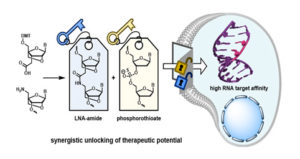Increasing the potential of the next generation therapeutic oligonucleotides

Applications: Oligonucleotide chemistry, biopharmaceuticals, molecular diagnostics, biomaterials, RNAi therapeutics
Chemical synthesis strategy for increasing the stability and biocompatibility of chemically-synthesised therapeutic oligonucleotides to enable broader medical application of the technology.
| Features | Benefits |
|
|
|
|
|
|
|
|
|
|
about this technology
© Oxford University Innovation

